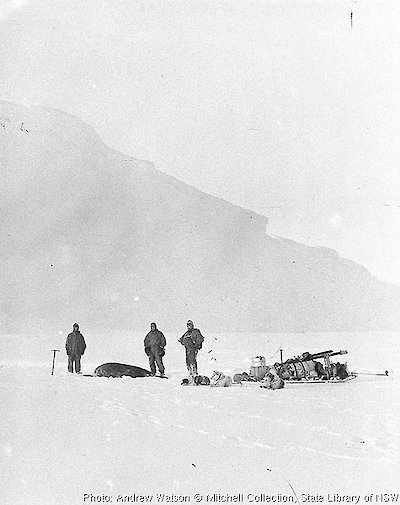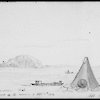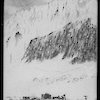Investigating the ice shelf
In their own words
The wind freshened towards sunset and blew hard throughout the night — such a flogging and straining that one would think the little tents would never survive! Moon shining through the cloth of the tent. Morning dawned without much abatement of the gale, though the sun rose and is shining brightly. Still the roar and flogging, creaking, whipping, string of drift. The whole uproar of the blizzard continues. But the hard snow beneath me is steady, I could lie here listening to it all. Fancy myself at sea again!
— Harrisson’s diary, 29 August 1912
On a clear day on 22 August, with Antarctica still in the firm grip of winter, a six-man party (the same as the previous southern party except with Watson replacing Hoadley) set off to the east across Shackleton Ice Shelf. ‘Dog-assisted man-hauling’ was the mode of operation: the ‘Eastern Depot Party’ had only three dogs to help haul the load of two-thirds of a tonne.
On the last day of August, about 90 kilometres out from the Grottoes, the party found itself on the southeastern slopes of Henderson Island. From there, they looked south to ‘a great sweeping embayment of the coast’ where drifting snow swirled in great billows; they named it the Bay of Winds.
But the best part of the view was — at last — evidence of solid land: the first sighting of rocks since Aurora’s departure all those months ago. Harrisson recorded the group’s excitement:
Undoubted rocks at last! A large razor-backed rock or ‘nunatak’ in the east end of the ‘Bay of Winds’, several rocks shown on the coast behind it — a cliff face in one place … — still further along, a cliff of rock and other rock tops showing. Many miles ahead what appears to be another large nunatak, standing out in the glacier …
The next 30 kilometres was tough going, up and down over ice ridges. Ahead was a razor-backed rocky hump, 130 metres high, shaped like a hippopotamus, which they called ‘the Hippo’. There, Watson collected rocks while Harrisson made the first discoveries of plants — lichen and moss — on the Queen Mary Coast.
And there, 135 kilometres out from the Grottoes, with a persistent powerful wind from the southeast, Wild determined they should go no further. They deposited 200 kilograms of food on a sledge, covered by a snow mound and marked by a pole, and headed off south to investigate the continent’s coast before turning homeward.
Their adventures were far from over. Late in the evening of 4 September, camping 400 metres out from sheer cliffs, the men were startled by the tremendous roar of an ice avalanche: ‘The face of the cliff was veiled in a dense smoke of rising drift,’ wrote Harrisson, ‘that advanced towards us, spurting out white puffs at its foot where the blocks of the avalanche were bounding down the slope towards us.’ They named the place ‘Avalanche Rocks’.
The avalanche, and a succession of others through the night, did not reach them, but at breakfast time next morning a fierce gale split one of the tents, forcing them to take cover in a shallow crevasse. It was three days before they were able to leave their trench, but they made good progress back across the ice shelf. They miscalculated their position, reaching the edge of the ice shelf 11 kilometres north of the Grottoes. They reached home at last on 15 September.
Their winter-spring trek was an achievement of real note. While a party from Scott’s expedition had made a midwinter journey at Ross Island (unknown to Wild’s men at this stage), the greater distance covered in by the AAE men put this in a class of its own.



